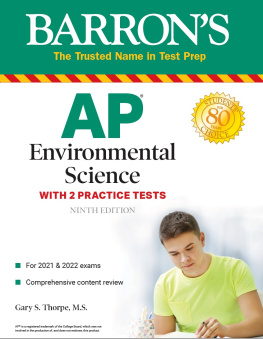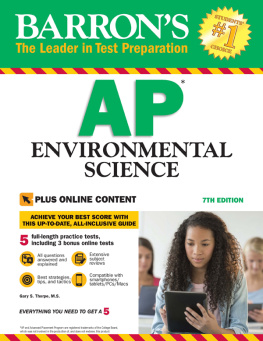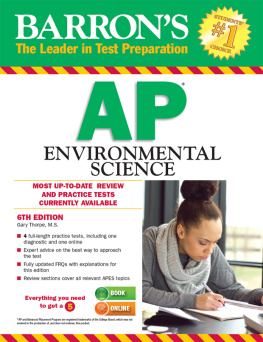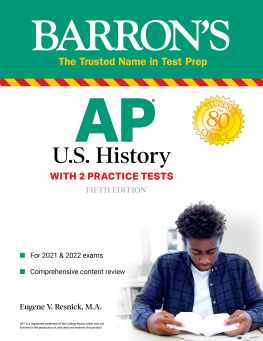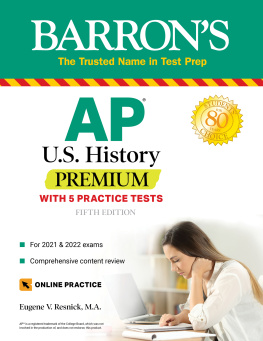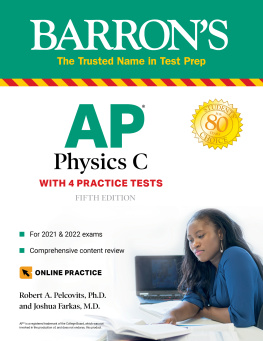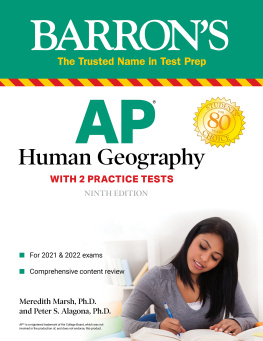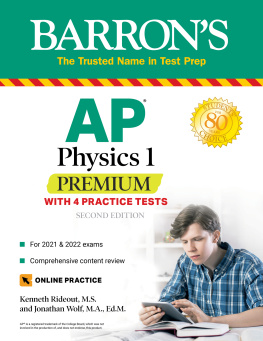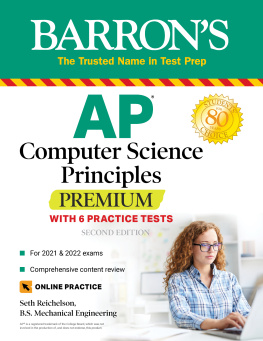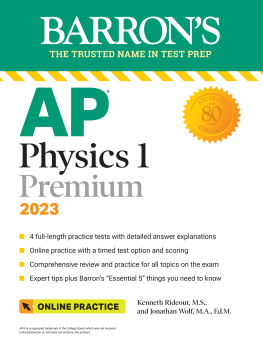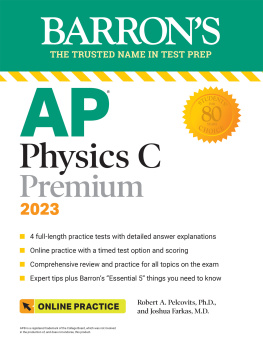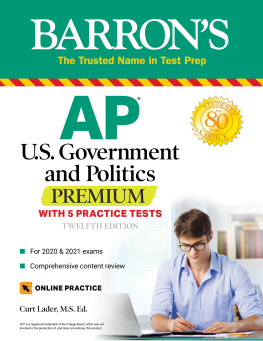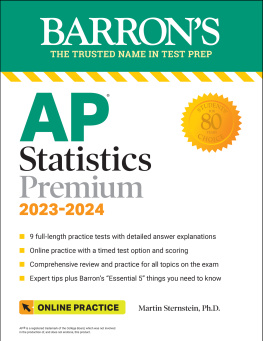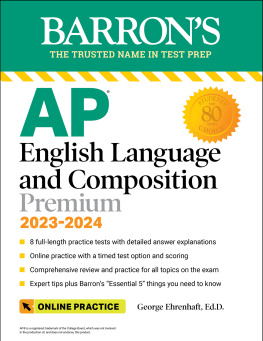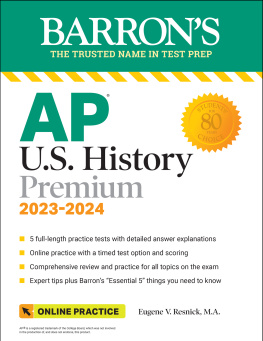Table of Contents
Guide
Page List

ACKNOWLEDGMENTS
I would like to thank my wife, Patti, for her understanding and patience; Brian Palm of Catholic Memorial High School in Roxbury, Massachusetts, for his help in writing many of the Free-Response Questions; and Jennifer Giammusso, Alison Maresca, and the rest of the staff at Barrons Publishing for their advice and support over the years.
Copyright 2020, 2017, 2015, 2013, 2011, 2009, 2007 by Kaplan, Inc., d/b/a Barrons Educational Series
Previous edition copyright 2002 under the title How to Prepare for the AP Environmental Science Exam by Kaplan, Inc., d/b/a Barrons Educational Series
All rights reserved under International and Pan-American Copyright Conventions. By payment of the required fees, you have been granted the non-exclusive, non-transferable right to access and read the text of this eBook on screen. No part of this text may be reproduced, transmitted, downloaded, decompiled, reverse engineered, or stored in or introduced into any information storage and retrieval system, in any form or by any means, whether electronic or mechanical, now known or hereinafter invented, without the express written permission of the publisher.
Published by Kaplan, Inc., d/b/a Barrons Educational Series
750 Third Avenue
New York, NY 10017
www.barronseduc.com
ISBN: 978-1-5062-7091-3
10 9 8 7 6 5 4 3 2 1
Contents
T he format of the AP Environmental Science exam changed in 2019 and you now have the most up-to-date prep book available anywhere. The following list details the changes.
There are now 80 multiple-choice questions on the exam with only four answer choices. You will still have 90 minutes for the multiple-choice questions; however, the multiple-choice questions on the actual test and in this book focus on having you analyze text, data, and graphs. Barrons has you covered.
There are three FRQs (Free-Response Questions), or essay questions, on the exam, with the time being reduced to 70 minutes.
A total of five practice exams are included with this booktwo in the book and three onlinewhich can be taken under actual timed conditions. Your scores on these practice exams will help you prepare for test day. All answers are fully explained.
Barrons new third edition flashcards have been correlated with this ninth editionuse the flashcards one month before the actual APES exam as a quick review to ensure that 5!
As you review the content in this book and work toward earning that on your AP ENVIRONMENTAL SCIENCE exam, here are five things that you MUST do:
Practice writing your own answers to the Free-Response Questions (FRQs). After you review each FRQ, close this book and write your own response to the question. Then, compare your answer to the one in this book. The more you practice writing your own responses, the higher your score will be on the actual APES exam.
Be sure to review the Case Studies presented in this book. You will find several questions on the exam that focus on specific events that have occurred throughout history and involve environmental science principles and issues. When possible, reference these Case Studies in your responses to the FRQs.
The AP Environmental Science exam now focuses on having you analyze data and draw logical conclusions. All practice tests in the revised ninth edition have been rewritten to reinforce this required skill.
Become comfortable with doing the types of math problems found in this book, especially those involving energy calculations. These problems are found in and in both practice exams.
Review the relevant acts, laws, and treaties detailed in each chapter. You will find several questions on the APES exam that test your knowledge on them; you can also reference them in your answers to the FRQs when appropriate.
Q: WHATS THE BEST WAY TO PREPARE FOR THE NEW APES EXAM?
A: Barrons AP Environmental Science is NOT a cram book to be used at the last minute, but was designed to be used throughout your AP Environmental Science course to reinforce the most important concepts that you will find on the APES exam. Also, be sure to use Barrons third edition flashcards (available from Amazon and other fine retailers) in the last few weeks before the exam to fill in any gaps.
Q: HOW ARE THE MULTIPLE-CHOICE QUESTIONS GRADED?
A: The new AP Environmental Science exam now has only 80 multiple-choice questions, which you need to complete in 90 minutes. In addition, now there are only four answer choices to choose from. Also, the format of the questions has changed, requiring you to read and analyze text and graphs. The two practice exams found in this book and the three online practice exams focus on this new format.
Q: HOW ARE THE FREE-RESPONSE QUESTIONS (FRQs) GRADED?
A: The new AP Environmental Science exam now has only three essay questions, also known as Free-Response Questions (FRQs), which you need to complete in 70 minutes. Barrons uses FRQs submitted by AP Environmental Science teachers from across the United States, along with complete scoring guides (rubrics).
Q: WILL I FIND QUESTIONS ABOUT LABS?
A: Yes. In this new test format, the emphasis is on reading and interpreting data and analyzing graphs. An exciting and new component to this book is that every chapter has at least one online APES lab investigation. You will be provided the background to the lab, the directions on how to perform the lab, and the data had you actually done the lab. You will then be asked to analyze and interpret the data, draw graphs, etc. No other APES test prep book includes this new and important feature.
Q: WHAT DO THE SCORES MEAN?
A: Scores range from 1, being the lowest, to 5, being the highest. For many colleges, scores of 3, 4, or 5 are generally considered passing and are given full college credit. Go to https://apstudent.collegeboard.org/creditandplacement/search-credit-policies to find out which colleges accept AP credit and what scores are required. Historically, about half of the students who take the APES exam pass and about half do not pass.
5: Passing: ~9% of students
4: Passing: ~25% of students
3: Passing: ~15% of students
2: Not passing: ~25% of students
1: Not passing: ~26% of students
Q: WHAT MATERIALS DO I TAKE WITH ME TO THE EXAM?
A: Admission ticket
Black or blue erasable pens for the FRQs
Official photo (e.g., student ID), including signature
Several sharpened #2 pencils with non-smudging erasers
Social security number
Watch
Calculatorstudents will be permitted to use a scientific or four-function calculator on both sections of the exam.
DO NOT BRING
Cell phones
Colored pencils
Food or drink
Highlighters
Rulers
Q: SHOULD I GUESS?
A: Yes. There is no penalty for guessing.
Q: CAN I CANCEL MY SCORES?
A: Yes; however, your request must be received by June 15. You may also request one or more of your scores NOT be sent to colleges.
Q: CAN I WRITE ON THE TEST BOOKLET?
A: Yes. Use the test booklet to make brief outlines of how you want to organize your FRQs (essays) or do math calculations. Several examples of this technique are presented in this book.
Q: HOW DO I GET MORE INFORMATION?

